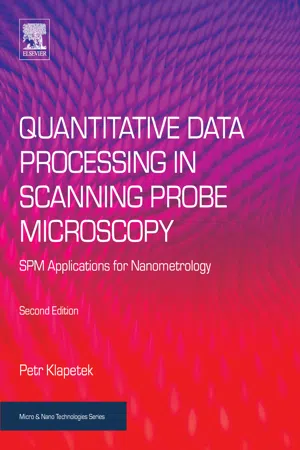
Quantitative Data Processing in Scanning Probe Microscopy
SPM Applications for Nanometrology
- 416 pages
- English
- ePUB (mobile friendly)
- Available on iOS & Android
Quantitative Data Processing in Scanning Probe Microscopy
SPM Applications for Nanometrology
About This Book
Quantitative Data Processing in Scanning Probe Microscopy: SPM Applications for Nanometrology, Second Edition describes the recommended practices for measurements and data processing for various SPM techniques, also discussing associated numerical techniques and recommendations for further reading for particular physical quantities measurements. Each chapter has been revised and updated for this new edition to reflect the progress that has been made in SPM techniques in recent years. New features for this edition include more step-by-step examples, better sample data and more links to related documentation in open source software.
Scanning Probe Microscopy (SPM) techniques have the potential to produce information on various local physical properties. Unfortunately, there is still a large gap between what is measured by commercial devices and what could be considered as a quantitative result. This book determines to educate and close that gap.
Associated data sets can be downloaded from http://gwyddion.net/qspm/
- Features step-by-step guidance to aid readers in progressing from a general understanding of SPM principles to a greater mastery of complex data measurement techniques
- Includes a focus on metrology aspects of measurements, arming readers with a solid grasp of instrumentation and measuring methods accuracy
- Worked examples show quantitative data processing for different SPM analytical techniques
Frequently asked questions
Information
Motivation
Abstract
Keywords
1.1 Why “Quantitative” Scanning Probe Microscopy?
- • How can I calibrate my SPM to get accurate results?
- • How precisely can I measure dimensions of nanoobjects?
- • How can I interpret force–distance curves?
- • What spatial resolution can I expect in thermal/magnetic/electric/optical measurements and how to evaluate it?
- • Can I resolve different chemical species in ambient SPM measurements?
- • Can I measure the local material refractive index using SPM?
Table of contents
- Cover image
- Title page
- Table of Contents
- Copyright
- List of Contributors
- Preface to the Second Edition
- Preface to the First Edition
- Chapter 1: Motivation
- Chapter 2: Instrumentation Principles
- Chapter 3: Data Models
- Chapter 4: Basic Data Processing
- Chapter 5: Dimensional Measurements
- Chapter 6: Force and Mechanical Properties
- Chapter 7: Friction and Lateral Forces
- Chapter 8: Electrostatic Fields
- Chapter 9: Magnetic Fields
- Chapter 10: Local Current Measurements
- Chapter 11: Thermal Measurements
- Chapter 12: Optical Measurements
- Chapter 13: Sample Data Files
- Chapter 14: Numerical Modeling Techniques
- Index